译林版(2019)选择性必修第一册 Unit 1 Food Matters Extended reading 课件(28张)
文档属性
| 名称 | 译林版(2019)选择性必修第一册 Unit 1 Food Matters Extended reading 课件(28张) | 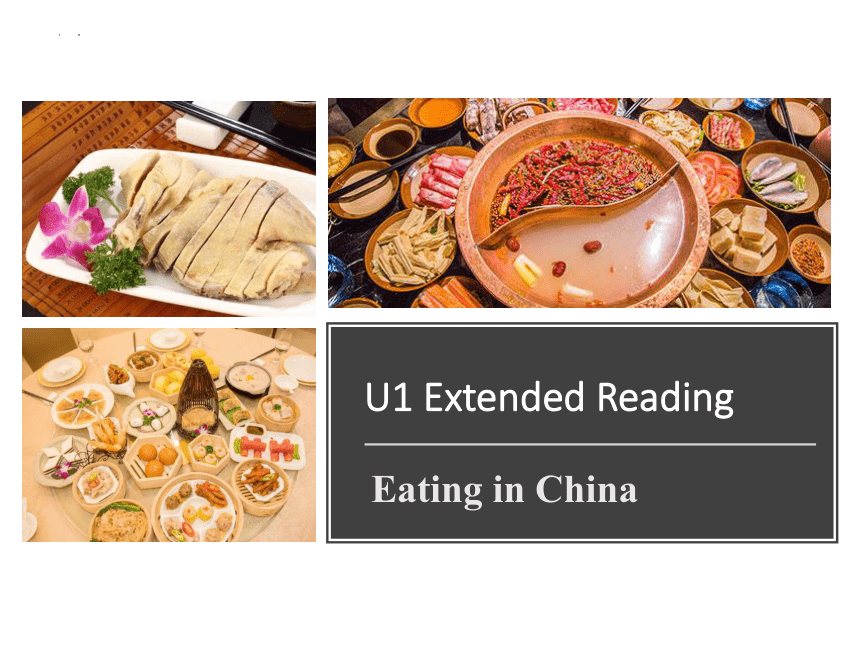 | |
| 格式 | pptx | ||
| 文件大小 | 13.7MB | ||
| 资源类型 | 教案 | ||
| 版本资源 | 牛津译林版(2019) | ||
| 科目 | 英语 | ||
| 更新时间 | 2022-09-21 11:27:58 | ||
图片预览

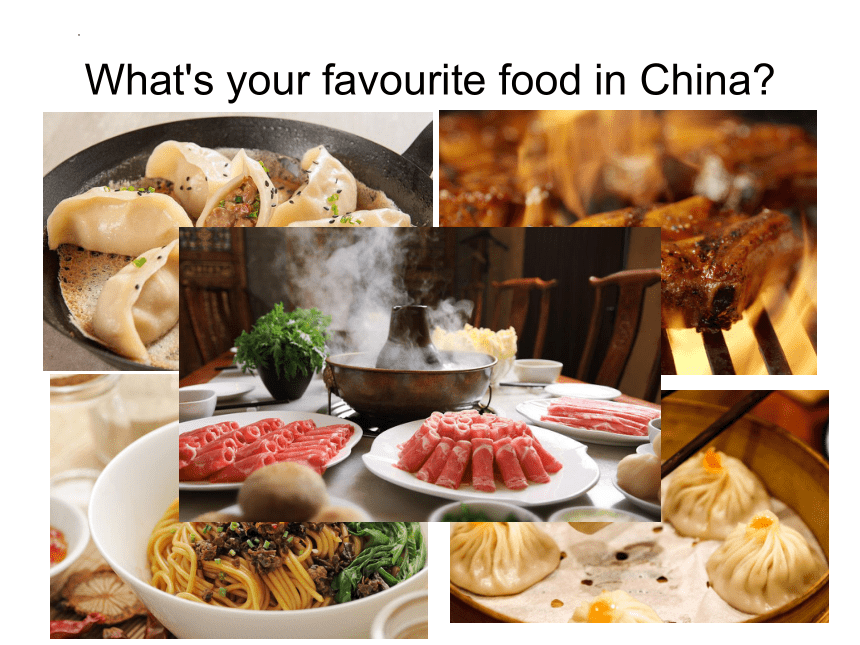
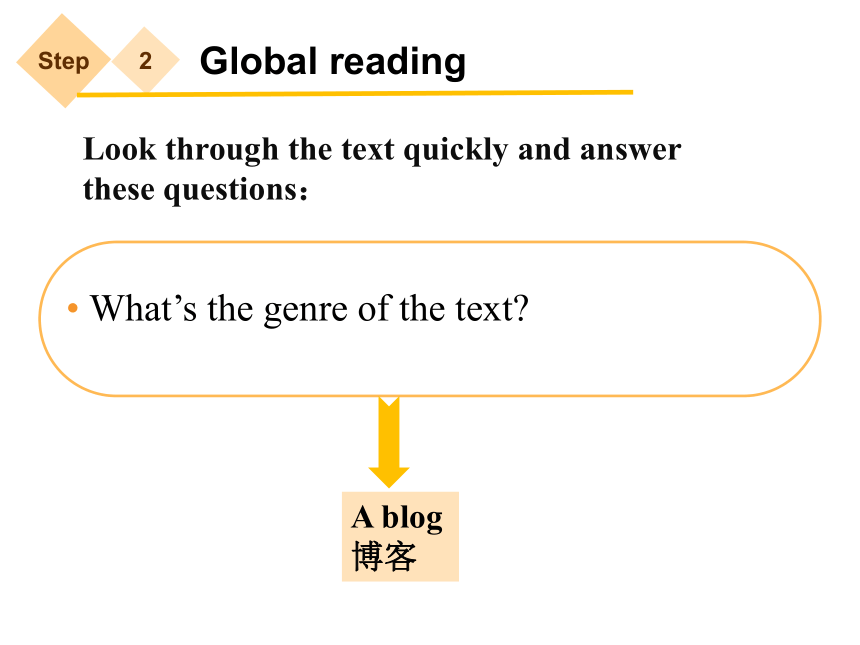
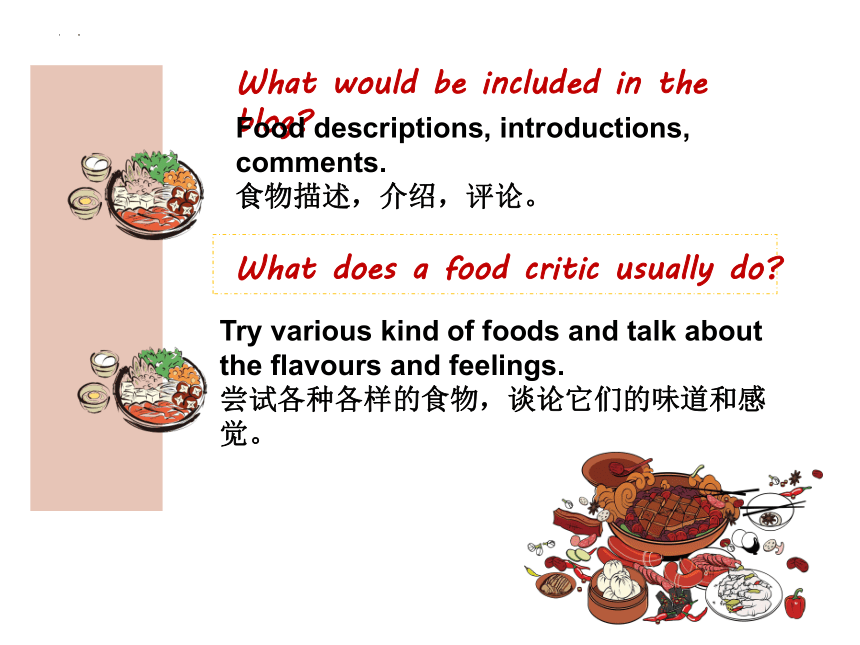
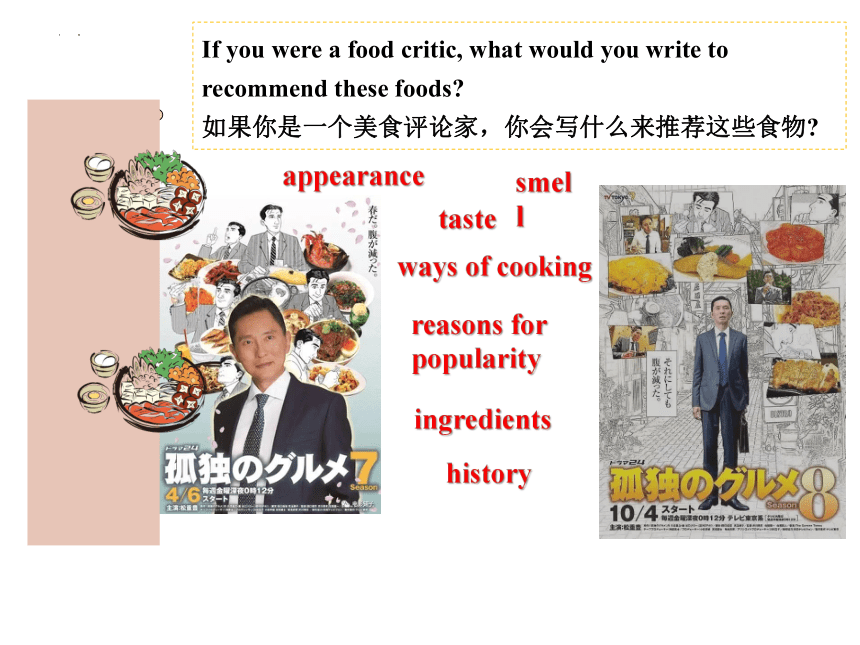
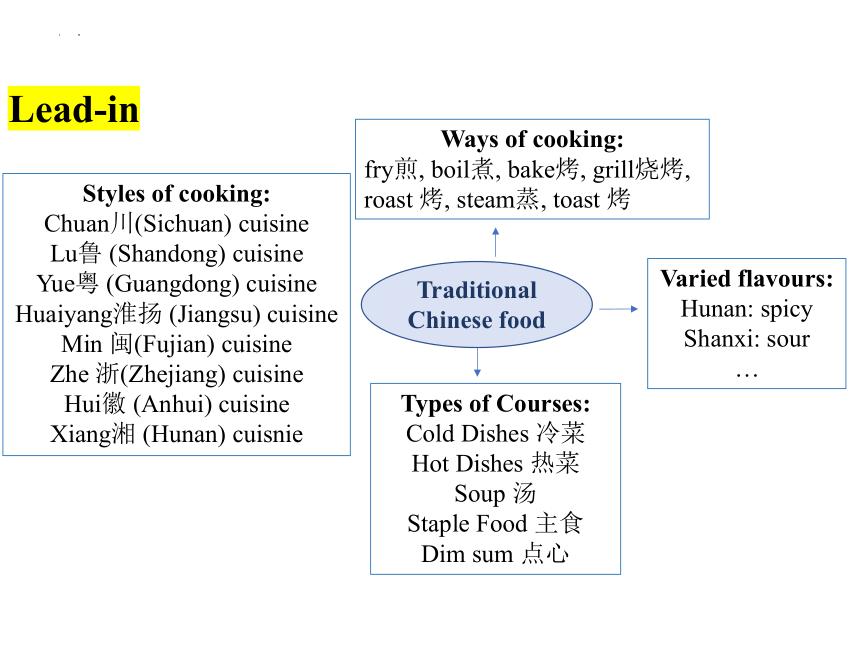
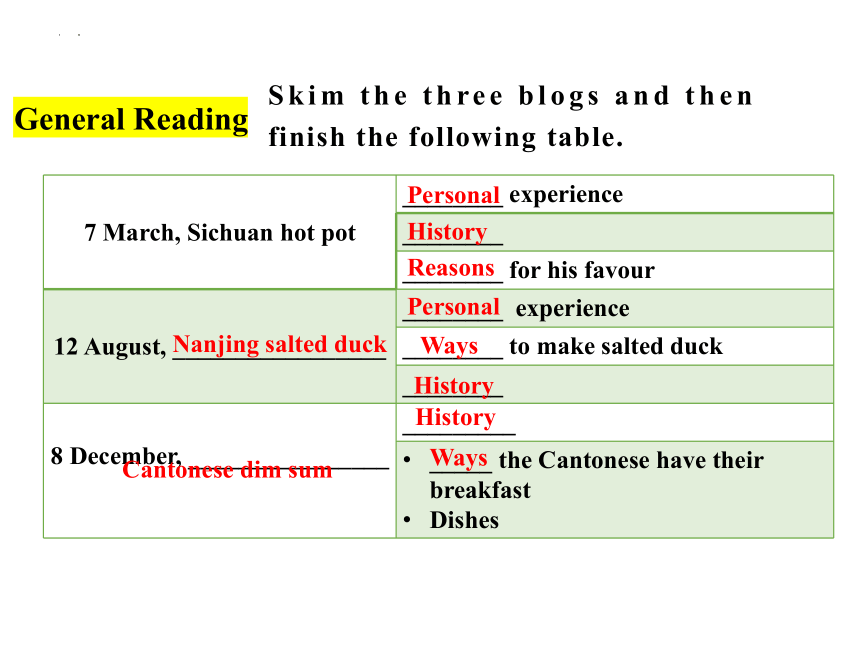
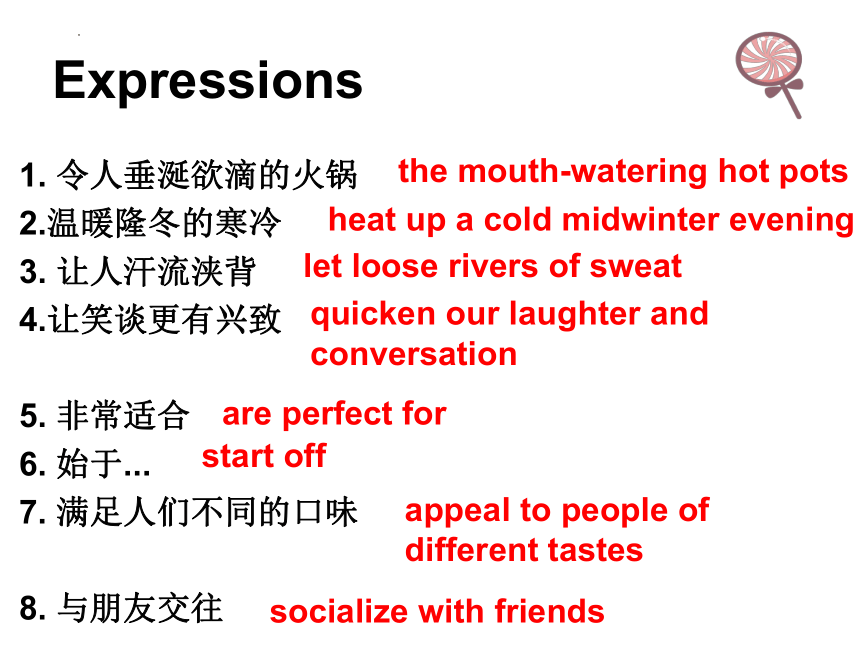
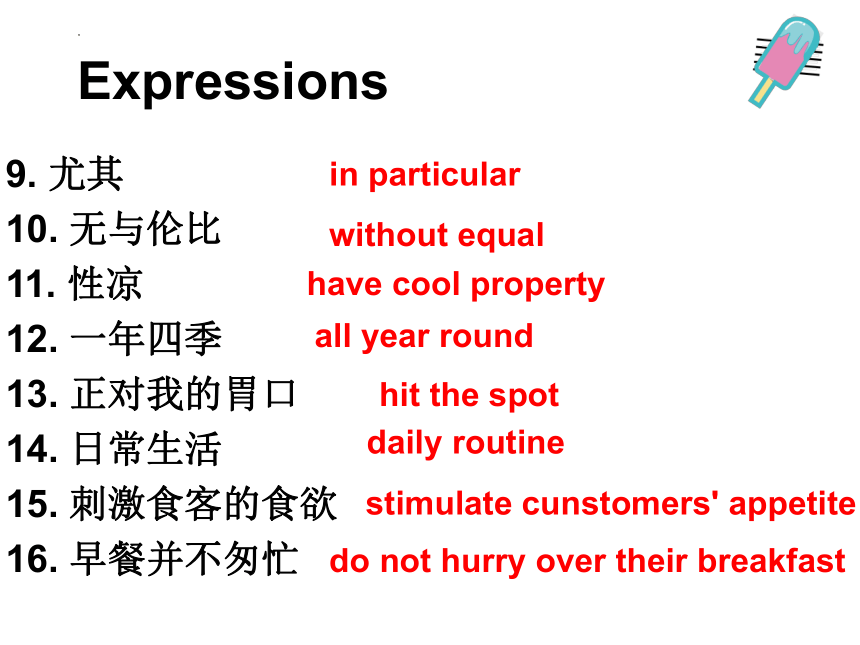
文档简介
(共28张PPT)
U1 Extended Reading
Eating in China
What's your favourite food in China
Step
2
Global reading
Look through the text quickly and answer these questions:
What’s the genre of the text
A blog
博客
What would be included in the blog
Food descriptions, introductions, comments.
食物描述,介绍,评论。
Try various kind of foods and talk about the flavours and feelings.
尝试各种各样的食物,谈论它们的味道和感觉。
What does a food critic usually do
If you were a food critic, what would you write to recommend these foods
如果你是一个美食评论家,你会写什么来推荐这些食物
taste
appearance
ingredients
ways of cooking
history
smell
reasons for
popularity
Ways of cooking:
fry煎, boil煮, bake烤, grill烧烤, roast 烤, steam蒸, toast 烤
Traditional Chinese food
Styles of cooking:
Chuan川(Sichuan) cuisine
Lu鲁 (Shandong) cuisine
Yue粤 (Guangdong) cuisine
Huaiyang淮扬 (Jiangsu) cuisine
Min 闽(Fujian) cuisine
Zhe 浙(Zhejiang) cuisine
Hui徽 (Anhui) cuisine
Xiang湘 (Hunan) cuisnie
Varied flavours:
Hunan: spicy
Shanxi: sour
…
Types of Courses:
Cold Dishes 冷菜
Hot Dishes 热菜
Soup 汤
Staple Food 主食
Dim sum 点心
Lead-in
Skim the three blogs and then finish the following table.
7 March, Sichuan hot pot ________ experience
________
________ for his favour
12 August, _________________ ________ experience
________ to make salted duck
________
8 December, ________________ _________
_____ the Cantonese have their breakfast
Dishes
Personal
Nanjing salted duck
History
Reasons
Personal
Ways
Cantonese dim sum
History
History
Ways
General Reading
Expressions
1. 令人垂涎欲滴的火锅
2.温暖隆冬的寒冷
3. 让人汗流浃背
4.让笑谈更有兴致
5. 非常适合
6. 始于...
7. 满足人们不同的口味
8. 与朋友交往
the mouth-watering hot pots
heat up a cold midwinter evening
let loose rivers of sweat
quicken our laughter and
conversation
are perfect for
start off
appeal to people of
different tastes
socialize with friends
9. 尤其
10. 无与伦比
11. 性凉
12. 一年四季
13. 正对我的胃口
14. 日常生活
15. 刺激食客的食欲
16. 早餐并不匆忙
in particular
without equal
have cool property
all year round
hit the spot
daily routine
stimulate cunstomers' appetite
do not hurry over their breakfast
Expressions
17. 慢慢吃遍菜单上所有点心
18. 列出一个长长的清单
work their way through the menu
have a long list of
Expressions
Eating in China
7 March
Sichuan hot pot
12 August
Nanjing salted duck
8 December
Cantonese dim sum
Where did the critic go
Eating in China
7 March
Sichuan hot pot
Sichuan hot pot
popularity
benefits
features
ingredients
making process
flavour
→famous both in China and overseas
→1.heat up a cold midwinter evening
3. offer the best way to relax with friends
→multiple soups, vegetables, meat, and sauces
→ boil various ingredients
→hot, spicy
history
time
background information
→started off in the late Qing Dynasty
→the damp, foggy climate
2. let loose rivers of sweat on a summer afternoon
When do Sichuan hot pots date back to
They are believed to date to the late Qing Dynasty.
它们被认为可以追溯到清朝晚期。
Sichuan hot pot
________ of Sichuan hot pot
When:
Who:
Why:
What: (In the beginning)
(Over time)
in the late Qing Dynasty
boatmen on the Yangtze River
to keep warm during the cold and wet winters
boiling vegetables, chillies and Sichuan peppers in water
History
(para 2)
multiple options of soups, vegetables, meats and sauces
四川火锅
http://t.cn/RQXzrzI
Eating in China
7 March
Sichuan hot pot
12 August
Nanjing salted duck
Nanjing salted duck
How is Nanjing salted duck served, and what is its flavour 南京的盐水鸭是怎么吃的 味道如何
How is the salted duck made 盐水鸭是怎么做的
popularity
benefits
features
ingredients
making process
flavour
→most famous food export in Nanjing
→have cooling properties in hot summer
→thin and white duck slices
→salting, drying boiling, and cooling
→juicy and salty
history
time
background information
→was praised in the late Qing Dynasty
→countless waterways are perfect for raising ducks
Nanjing salted duck
Nanjing salted duck
Why is Nanjing salted duck so popular
Firstly, Nanjing has countless waterways, making it a perfect area for raising waterbirds.
首先,南京有无数的水道,是饲养水鸟的理想之地。
Secondly, duck is traditionally considered to have cooling properties, which is appropriate for the hot summer months.
其次,鸭肉传统上被认为具有降温的特性,适合炎热的夏季食用。
南京盐水鸭
https://www./video/BV15W41137oK share_source=copy_web
Eating in China
7 March
Sichuan hot pot
12 August
Nanjing salted duck
8 December
Cantonese dim sum
Cantonese dim sum
In the middle of the 19th c entury,______.
A. teahouses became common in Guangzhou
B. people in Guang zhou began to drink tea in the morning
C. tea began to be served together with a variety of dim sum
D. Guangzhou’s restaurants began to make dim sum in the morning
popularity
benefits
features
ingredients
making process
flavour
→morning tea is essential part in the daily routine
→give people hours to have conversations about business, family or pleasure
→ various dishes such as beef balls and rice noodles rolls
→ baking, boiling, steaming or frying
→ light
history
time
background information
was served with tea in the mid-19th century
→ Teahouses have been common in China since the Tang Dynasty
Cantonese dim sum
广东早茶
https://www./video/BV1tt4y1y7h5 share_source=copy_web
Discussion
What factors contribute to the food differences in China
climate 气候
geography 地理
culture 文化
history 历史
Appreciation
When describing the features of the foods, the author uses a lot of adjectives. Fill in the table and discuss the effects these adjectives create.在描述食物的特征时,作者使用了大量的形容词。填表并讨论这些形容词造成的影响。
Sichuan hot pots
Nanjing salted duck
Cantonese dim sum
mouth-watering, beautiful, delicious
plain, thin, white, juicy, salty
delicate, delicious, various
The critic uses these adjectives to describe plenty of sensory details to help readers create vivid pictures of the foods in mind.
评论家用这些形容词来描述大量的感官细节,以帮助读者在脑海中形成食物的生动形象。
How to introduce food
history
fetures
popularity
ways of cooking
并列or部分融合
U1 Extended Reading
Eating in China
What's your favourite food in China
Step
2
Global reading
Look through the text quickly and answer these questions:
What’s the genre of the text
A blog
博客
What would be included in the blog
Food descriptions, introductions, comments.
食物描述,介绍,评论。
Try various kind of foods and talk about the flavours and feelings.
尝试各种各样的食物,谈论它们的味道和感觉。
What does a food critic usually do
If you were a food critic, what would you write to recommend these foods
如果你是一个美食评论家,你会写什么来推荐这些食物
taste
appearance
ingredients
ways of cooking
history
smell
reasons for
popularity
Ways of cooking:
fry煎, boil煮, bake烤, grill烧烤, roast 烤, steam蒸, toast 烤
Traditional Chinese food
Styles of cooking:
Chuan川(Sichuan) cuisine
Lu鲁 (Shandong) cuisine
Yue粤 (Guangdong) cuisine
Huaiyang淮扬 (Jiangsu) cuisine
Min 闽(Fujian) cuisine
Zhe 浙(Zhejiang) cuisine
Hui徽 (Anhui) cuisine
Xiang湘 (Hunan) cuisnie
Varied flavours:
Hunan: spicy
Shanxi: sour
…
Types of Courses:
Cold Dishes 冷菜
Hot Dishes 热菜
Soup 汤
Staple Food 主食
Dim sum 点心
Lead-in
Skim the three blogs and then finish the following table.
7 March, Sichuan hot pot ________ experience
________
________ for his favour
12 August, _________________ ________ experience
________ to make salted duck
________
8 December, ________________ _________
_____ the Cantonese have their breakfast
Dishes
Personal
Nanjing salted duck
History
Reasons
Personal
Ways
Cantonese dim sum
History
History
Ways
General Reading
Expressions
1. 令人垂涎欲滴的火锅
2.温暖隆冬的寒冷
3. 让人汗流浃背
4.让笑谈更有兴致
5. 非常适合
6. 始于...
7. 满足人们不同的口味
8. 与朋友交往
the mouth-watering hot pots
heat up a cold midwinter evening
let loose rivers of sweat
quicken our laughter and
conversation
are perfect for
start off
appeal to people of
different tastes
socialize with friends
9. 尤其
10. 无与伦比
11. 性凉
12. 一年四季
13. 正对我的胃口
14. 日常生活
15. 刺激食客的食欲
16. 早餐并不匆忙
in particular
without equal
have cool property
all year round
hit the spot
daily routine
stimulate cunstomers' appetite
do not hurry over their breakfast
Expressions
17. 慢慢吃遍菜单上所有点心
18. 列出一个长长的清单
work their way through the menu
have a long list of
Expressions
Eating in China
7 March
Sichuan hot pot
12 August
Nanjing salted duck
8 December
Cantonese dim sum
Where did the critic go
Eating in China
7 March
Sichuan hot pot
Sichuan hot pot
popularity
benefits
features
ingredients
making process
flavour
→famous both in China and overseas
→1.heat up a cold midwinter evening
3. offer the best way to relax with friends
→multiple soups, vegetables, meat, and sauces
→ boil various ingredients
→hot, spicy
history
time
background information
→started off in the late Qing Dynasty
→the damp, foggy climate
2. let loose rivers of sweat on a summer afternoon
When do Sichuan hot pots date back to
They are believed to date to the late Qing Dynasty.
它们被认为可以追溯到清朝晚期。
Sichuan hot pot
________ of Sichuan hot pot
When:
Who:
Why:
What: (In the beginning)
(Over time)
in the late Qing Dynasty
boatmen on the Yangtze River
to keep warm during the cold and wet winters
boiling vegetables, chillies and Sichuan peppers in water
History
(para 2)
multiple options of soups, vegetables, meats and sauces
四川火锅
http://t.cn/RQXzrzI
Eating in China
7 March
Sichuan hot pot
12 August
Nanjing salted duck
Nanjing salted duck
How is Nanjing salted duck served, and what is its flavour 南京的盐水鸭是怎么吃的 味道如何
How is the salted duck made 盐水鸭是怎么做的
popularity
benefits
features
ingredients
making process
flavour
→most famous food export in Nanjing
→have cooling properties in hot summer
→thin and white duck slices
→salting, drying boiling, and cooling
→juicy and salty
history
time
background information
→was praised in the late Qing Dynasty
→countless waterways are perfect for raising ducks
Nanjing salted duck
Nanjing salted duck
Why is Nanjing salted duck so popular
Firstly, Nanjing has countless waterways, making it a perfect area for raising waterbirds.
首先,南京有无数的水道,是饲养水鸟的理想之地。
Secondly, duck is traditionally considered to have cooling properties, which is appropriate for the hot summer months.
其次,鸭肉传统上被认为具有降温的特性,适合炎热的夏季食用。
南京盐水鸭
https://www./video/BV15W41137oK share_source=copy_web
Eating in China
7 March
Sichuan hot pot
12 August
Nanjing salted duck
8 December
Cantonese dim sum
Cantonese dim sum
In the middle of the 19th c entury,______.
A. teahouses became common in Guangzhou
B. people in Guang zhou began to drink tea in the morning
C. tea began to be served together with a variety of dim sum
D. Guangzhou’s restaurants began to make dim sum in the morning
popularity
benefits
features
ingredients
making process
flavour
→morning tea is essential part in the daily routine
→give people hours to have conversations about business, family or pleasure
→ various dishes such as beef balls and rice noodles rolls
→ baking, boiling, steaming or frying
→ light
history
time
background information
was served with tea in the mid-19th century
→ Teahouses have been common in China since the Tang Dynasty
Cantonese dim sum
广东早茶
https://www./video/BV1tt4y1y7h5 share_source=copy_web
Discussion
What factors contribute to the food differences in China
climate 气候
geography 地理
culture 文化
history 历史
Appreciation
When describing the features of the foods, the author uses a lot of adjectives. Fill in the table and discuss the effects these adjectives create.在描述食物的特征时,作者使用了大量的形容词。填表并讨论这些形容词造成的影响。
Sichuan hot pots
Nanjing salted duck
Cantonese dim sum
mouth-watering, beautiful, delicious
plain, thin, white, juicy, salty
delicate, delicious, various
The critic uses these adjectives to describe plenty of sensory details to help readers create vivid pictures of the foods in mind.
评论家用这些形容词来描述大量的感官细节,以帮助读者在脑海中形成食物的生动形象。
How to introduce food
history
fetures
popularity
ways of cooking
并列or部分融合
同课章节目录
- Unit 1 Food matters
- Welcome to the unit
- Reading
- Grammar and usage
- Integrated skills
- Extended reading
- Project
- Unit 2 The Universal Language
- Welcome to the unit
- Reading
- Grammar and usage
- Integrated skills
- Extended reading
- Project
- Unit 3 The art of painting
- Welcome to the unit
- Reading
- Grammar and usage
- Integrated skills
- Extended reading
- Project
- Unit 4 Exploring poetry
- Welcome to the unit
- Reading
- Grammar and usage
- Integrated skills
- Extended reading
- Project
